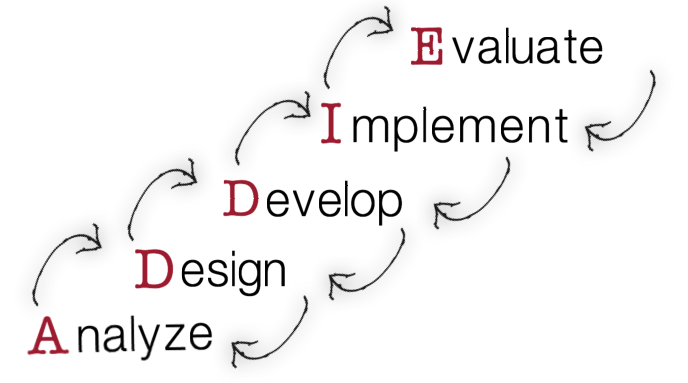I like ADDIE. She’s like that friend who’s always there for you. She’s dependable, flexible, and keeps you on course (pun intended). Sure, she’s not as trendy or exciting as some of your other friends. Rarely is she the life of party, but you can count on her to never steer you wrong.
ADDIE is of course not a real person – although I wish at times she was. The ADDIE model is one of the most-used Instructional Systems Design (ISD) models in the curriculum and instructional design worlds. Like all good frameworks, ADDIE is a mnemonic that lays out the five phases of instructional design, in order.
A generic model
There are many in the field who are critical of the ADDIE model suggesting it’s too ponderous and is not suited to rapid development needs or emergent learning practices. I couldn’t disagree more. I suspect that the folks who don’t like the model are just not using it as effectively or as flexibly as they could.
The ADDIE model is incredibly generic – for a reason. It’s to allow for adaption and flexibility. Having said that, each phase is important and if you’re designing learning without giving the phases their due, you’re likelihood of designing high-quality learning experiences is going to be a matter of luck more than planning, knowledge, and hard work.
Built for iteration
I think that another reason some folks dislike ADDIE is that she is seen as too process-driven and that each phase has to be completed in order. Learning is messy and learning design is often messier. It’s not unusual for multiple tasks across several phases to be done at the same time. In more complex learning design each task or answer to a question informs and influences other tasks, making interactive design a necessity.
Here’s a quick description of each of the phases in a downloadable pdf.
These descriptions are for designing training. Education design looks a little different, especially in the analysis phase. And yes, training and education are not the same thing.
What about backward design?
It’s not unusual for learning designers to be brought in to complete one phase or even one part of one phase of a full program or course design process. Designers that specialize in creating content may begin seeing more agile models and backward design (for example) as the only way to go, forgetting that there are stages before and after that have to be attended to by others. Backward Design is part of the Design phase, not a substitute for ADDIE. And ADDIE can be as agile as you need her to be.
That’s my ode to ADDIE. I love her. She is my rock. She’s always there, providing a solid foundation and quietly guiding me along the path to better learning design. Thank you ADDIE 🙂
P.S. For an extended history of ADDIE check out Don Clark’s post.

